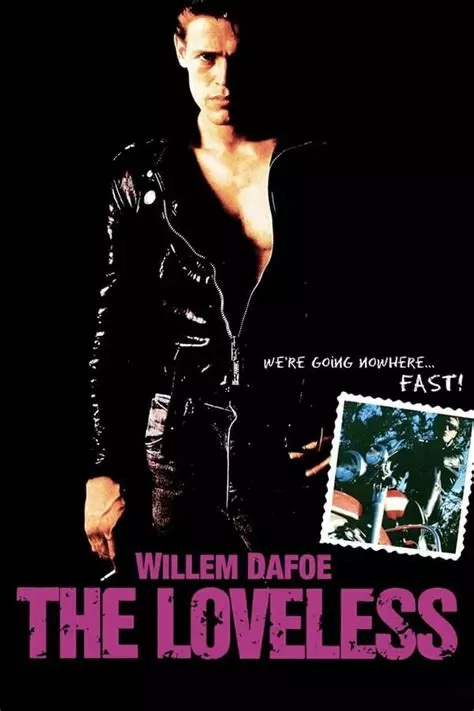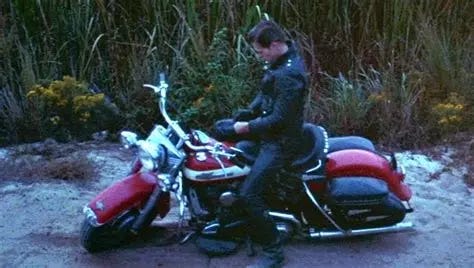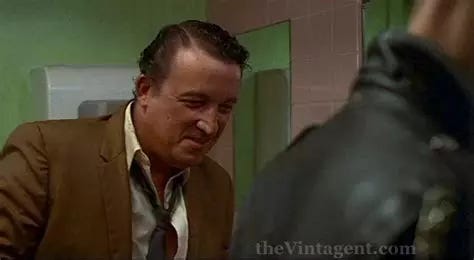The Loveless Film Review: America, Society, And The Aimless Road To Nowhere
“We're goin' nowhere... fast.”
Vance (Willem Dafoe) The Loveless
Hard and as machoesquce as Willem Dafoe’s delivery of that line may come off, in what is a unique break out role akin to something the Marlon Brandos and James Deans of cinema can be compared with, the tragedy that accompanies it comes from the wider scope that a film like The Loveless tackles. Although framed as an outlaw biker movie, The Loveless delves into existential territories the average film lover probably wouldn’t have noticed upon first viewing. It’s understandable given that if you’re looking for a plot, then The Loveless will short change you on that part, but for all the right reasons.
A majority of The Loveless has Vance (Willem Dafoe) and his crew of outlaw bikers all drift and drag around a rural roadside diner and gas station while en route to Daytona. Most of the conversations they have involve a lot of bravado trash talking, and the interactions they have with the presumably civilized people that are always ripe and ready to demonize them further illustrates the aimless trajectory of a film that is about more than just a gang of bikers and their place in society. The Loveless is a film about America, society, and how each of us attempts to fit into it, even when the clarity of its utter aimlessness seems apparent and tragically indifferent to our own psychological frustrations.
Where The American Outlaw Stands
Naturally, when framing a narrative around a group of outlaw bikers, the more obvious part of it revolves around their own place in the world as outlaws. But once the other characters demonstrate behavior that is in equal contradiction with the ideals and expectations of the society they assume that they fit in with the most, only shows how society itself is the real antagonist as opposed to the outlaw who simply walks a different path than what is expected, or even the hypocrite ready to compare them to something of a Luciferian degree. The Loveless was no doubt inspired by the 1953 film The Wild One, which starred Marlon Brando as a biker. But unlike the more romanticized depiction of outlaw Biker culture that a film like The Wild One celebrates, The Loveless employs a far more bleak depiction of both the outlaw, the civilized citizen, and the society that forms their own opinions of one another, essentially delving into the sorts of nihilistic realms that reveal something more tragic about the culture that assigns these two archetypes labels rather than any actual human dimension.
The times of the greasers, which were centered around the 1950’s were radically different than the present times, in terms of how morality was framed. Back then, it was more acceptable to look at things like good and evil in a much more black and white fashion as a way of crafting a more utilizable moral standard of which for a society/culture to abide by. But given that the human animal is a far more complex creature than what we’d like to give it credit for, any simplistic notions of morality are among the many themes explored and deconstructed in The Loveless, which although slow and often times aimless, it still manages to state how directionless America is in many respects. But that isn’t a very surprising thing to reflect on. It isn’t even much of a revelation because of the fact that how relatively young the country is, despite it’s rapid technological acceleration, which hasn’t added much cultural maturity to our society in the wake of how we handle tragedies, catastrophes, or even massive cultural shifts. If anything, it’s only increased the tension between people and the differences amongst themselves.
The Characters In The Loveless
The Loveless doesn’t explore the prospect of technology. But it does focus on social divisions on a cultural level through the differentiation the Greasers have as opposed to the more conventional members of society. This is immediately expressed on the first introductory shot of the central character Vance, played by Willem Dafoe, who just through the relaxed but equally intense body language, he conveys a feeling of an outsider that doesn’t fit in with his surroundings, despite being at complete peace with that sense of always being out of place. This is expressed best in many of the scenes where he in the diner, where considerable periods of time pass of nothing much happening, yet with him not caring next to nothing. This same devil don’t give a fuck attitude is carried out in his interactions with many of the characters in the film. It can be an exchange with one of his gang members asserting their own dominance, or attempting to challenge the already settled authority his presence establishes, or it can be one of the more traditionally acceptable members of civilized society who bare no shame or manner of self-reflection in their superficial willingness to judge and label Vance and his crew as trash or even Communists, with no evidential bases for these criticisms to thrive on.
Aside from the snide diner owner, who never shies away from expressing her disapproval of her waitress’ moments of out right flirtation with Vance, the boorishly arrogant Tarver (J. Don Ferguson) shows next to no restraint in his willingness to violently demonize the bikers, so much so that the premeditated murder he plans near the end of the film is never questioned or explored with any sense of doubt. If anything, Tarver’s hatred for Vance and his fellow bikers goes well beyond his sleeping with his daughter. The irrationality that paints Tarver’s hatred hits deeper and with greater dimensionality than just a man who is enraged by the fact that Vance eventually slept with his daughter Telena (Marin Kanter). The lack of a verbal explanation for his rage-induced vendetta against bikers boils to the more conservative physicality he embodies and how that is contrasted to the more relaxed and free spirited fashion that Vance and his friends all carry. Unlike Tarver, who is dressed in a more traditional business-like attire, Vance and his friends all dawn the rebellious aesthetic of biker black leather, which already puts a target on their heads as societal outcasts that will never meet the respectable standards of a society that will accept men like Tarver, simply because they make money and dress in clothing suitable to a type of work place that is more about productive efficiency rather than any form of creative individuality. But instead of being an ardent champion of this societal ideology, Tarver’s venomously toned disgust for Vance and every biker out there is nothing more than a well hidden insecurity that wishes to conceal his own self-hatred towards himself and the person he is. Because of the lack of a deep explanation for as to why someone lik Tarver hates Vance and his friends with such a fervent passion, the film relies more on subtle remarks and a multitude of visual cues as a way of tipping the viewer on the deeper nature of such deep seated resentment.
The Dehumanizing Effects Of Conformity
In addition to the conservative attire that Tarver dawns, the abusive relationship he has with his daughter is made clear upon discovering the romantic night she spends with Vance. Nothing is stated outright, but the violent reaction Tarver has where he literally shoots two tires from his daughter’s car and then aggressively pulls her into his car showcases the chaotic nature of their relationship, and this is only further exemplified in the violent car crash they suffer just moments after this aggressive attempt at abusive domination destroys the one tender moment she shared with a person who saw her as a person, even if he acted like he didn’t. But that pales in comparison to the attempted murder Tarver makes at Vance and his fellow biker’s as a result of purposely baiting them. Prior to this attempted murder, Tarver goes on a pathetic rant where he berates and dehumanize the bikers, and there are plenty of moments where he stumbles and stutters in the most pitiful fashion to insult them. But again, that is further commentary on the society that advocates for a conformity that essentially turns the very person into something that is dehumanized, and capable of dehumanizing themselves in their attempts to dehumanize anyone who doesn’t meet the standards they have whole heartedly pledged their allegiance to. It is this same allegiance that essentially spells out an aimlessness that the film acknowledges as an ever present spectre that none of the characters can truly escape . It doesn’t matter whether it is the conventionally civilized people that actively play the game of society and judge anyone who is more liberated and less constrained by its socially intolerant confines, or the more free spirited bikers.
America And The Notion Of “Freedom”
The society that had aided in the formation of their own personas is one defined by a lack of a concrete identity, which is an ironic thing to grasp given that when it comes to how America defines and prides itself as the land of the free, the extremes that socially cultural devices such as the ones depicted in The Loveless only raise the question as to what it means to be free, especially when American culture itself promotes a multitude of freedoms that often come into conflict with one another. Whether it’s a debate on Socialism vs Capitalism, Democrat vs Republican, or Communism vs Anarchism, these types of collisions only highlight how confused the society is, even when it operates under the delusion of a definitive certitude, where all roads essentially point to nowhere, and the reality of that is terrifying to everyone in the film, be it the bikers who project this essence of a devil may care freedom versus the more conventionally normal people who see themselves as ideal upstanding citizens, simply because they dress properly, hold semi-respectable jobs, and demonstrate the sort of patriotism men like Vance would consider nothing more than an insecure need to believe in something, even if it had to be forced on you. The final moments of the Loveless are characterized by a sense of meaningless violence where even when a bad person like Tarver is shot by his emotionally vulnerable daughter, the unspoken damage has been done, and enough to warrant her own suicide. The tragedy of that scene is perfectly captured by the neutral gaze Vance demonstrates in witnessing something that would traumatize anyone else. Instead, the only reaction Vance gives is one of total acceptance, almost like it’s merely a part of the road he has come to terms with, even if the rest of America hasn’t.
There’s nothing optimistic or glamorous about a film like The Loveless. It’s utter lack of sensationalism, combined with the relaxed neutrality that it employs in its depiction of a differentiation in culture only adds to the tragedy that defines the setting of the story, as well as the fate of all the characters who feel they have followed a path that has brought them closer to obtaining a wholeness, as opposed to the aimlessness that Vance eventually recognizes to be the bane of his existence as a man who never had the urge to stay in one place for too long.
“No one knows where we are going, the aim of life has been forgotten, the end has been left behind. Man has set out at tremendous speed- to go nowhere.”
Jacques Ellul
If You wish to support me and the work I do, then feel free to donate what you can. Even a dollar restores my faith in humanity.
Bitcoin
bc1qmmwpt4jytdjqr0duahlrvnvyaxh8avymvgjzk7
Monero
89UPRSB1xRyFMUAXiAxr8TdpPKviKrDCZ2MYy1eSB6iHi82VDZoHZ8E5HR5RuZnoxSTYWuwrJ7jSe5VNVeBR76haJCghkdY
https://www.paypal.me/Vincentmurdock666
Affiliates
CashApp:
https://cash.app/$AndresIBenatar
https://cash.app/refer/P2DWNDH
ProtonVPN
https://pr.tn/ref/E8CMM7ETZZ9G
Swan Bitcoin
https://www.swanbitcoin.com/ViciousTheDevil
Fetch
https://referral.fetch.com/vvv3/referralsocial?code=3E1F4Y
Strike
https://invite.strike.me/IXEWYK
Ag1
Better Help:
https://www.betterhelp.com/rpc/59dbaa0a1e0d9bbc-5-01?utm_term=ref_v2_dd










